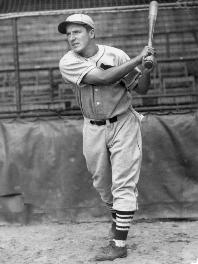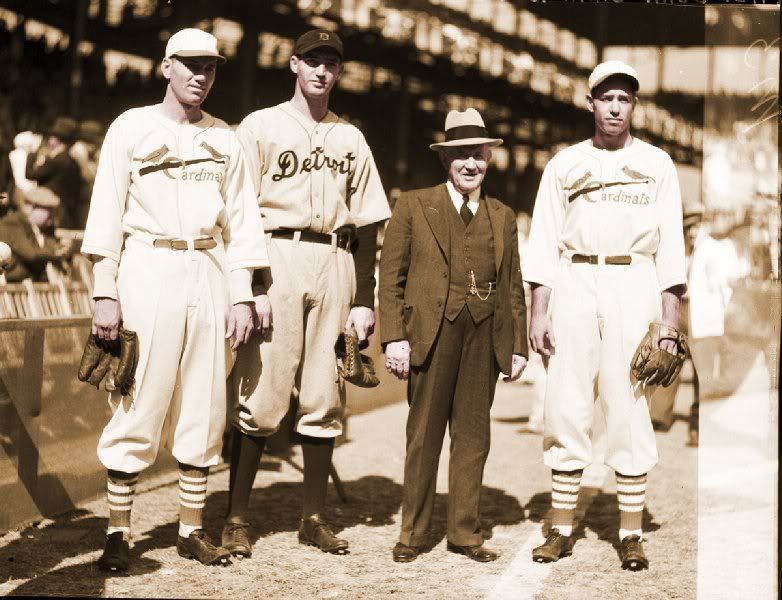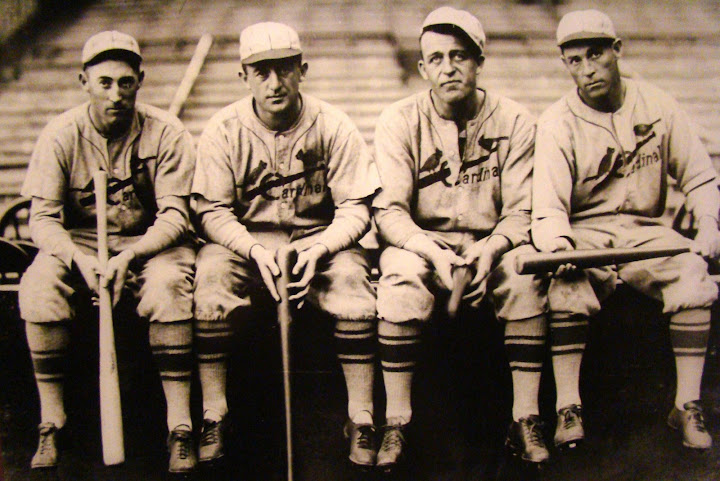 There has never been a team quite like the 1934 St. Louis Cardinals.
There has never been a team quite like the 1934 St. Louis Cardinals.
In the dredges of the Great Depression, a group of players who chewed tobacco, played covered in dirt (resembling gas station attendants, hence the nickname) and had their own bluegrass band squeaked out a dramatic pennant and won a seven game World Series.
Dizzy, Daffy, Ducky Wucky, Pepper, Lip and Flash were skilfully assembled by Branch Rickey, who used his nonpareil powers of talent evaluation and his innovative farm system to build the Cardinals to the top.
The men of the 1934 St. Louis Cardinals came from everywhere, traded for and bought by Rickey. Frankie Frisch, the Fordham Flash, was bought from the Giants and installed as second baseman and manager. The college man (Fordham was his alma mater) was immensely competitive, known for arguing vehemently against bad calls. Leo Durocher was a pool hustler from Massachusetts, a reprobate with a reputation for passing bad cheques and who would later be banned from baseball for a year for consorting with gamblers. The Lip, the Cards’ shortstop, was a vicious bench jockey.
Pepper Martin, ‘The Wild Horse of the Osage’, was the fastest man in baseball, so fast that folks claimed he ran down jackrabbits in his native Oklahoma to feed the family as a youngster. A prankster prone to dropping sneezing powder in hotel ventilation systems, he enjoyed driving his midget racing car around the warning track of Sportsman’s Park before games and led the Cardinal band, the Mississippi Mudcat Band. Joe Medwick was a taciturn man with a fierce temper, the product of his Hungarian parentage. But the muscular Medwick waddled when he walked, leading a generation of fans to call a Hall of Fame player ‘Ducky Wucky’.

Finally, there were the Dean boys. Paul Dean, a one-time sharecropper in Arkansas, was a quiet pitcher of considerable skill. He won 19 games as a rookie in 1934 and only the press’s need for a catchy nickname led him to being called Daffy. It was his brother who was the centre of attention.
Jerome Hanna Dean, or Dizzy as he was popularly known, was a 1930s pop culture icon. A man whose capacity to ravage the English language was matched only by his wit, he once stated, “I was blessed by the Lord – he gave me a strong arm, a good body, and a weak mind.†In 1934 he predicted that his brother and himself (he referred to them almost as one – ‘Me an’ Paul’) would win forty-five to fifty games. A second-grade dropout (‘I ain’t did so well in the first’) Dean had been discharged from the Army when he signed with a minor league team in Houston, and was only 22 when he was purchased by the Cardinals. A hard-throwing right hander with a good curveball and a master tactician on the mound, he had won 20 games in 1933 before making his big prediction.
The mastermind of the Cardinals was Rickey. A former catcher who had received a Juris Doctor degree from the University of Michigan, he had managed the Browns and then the Cardinals with sporadic success, but his baseball mind was regarded as one of the best and most thorough around. Rickey had built the Cardinals from virtually nothing – a derelict franchise in one of baseball’s smallest cities, they had lost on and off the field before Rickey’s arrival.
He instituted the farm system to circumvent minor league clubs who had sold off their best players to the more monied Giants and Cubs. Instead Rickey (with owner Sam Breadon’s money) would buy minor league clubs and develop talent themselves, teaching players Rickey’s philosophy on baseball from Class D to Class AA. Rickey had built the Cardinals into a respectable franchise by 1925, when Breadon relieved Rickey of managerial duties, arguing to Rickey that he was simply spreading himself too thin between trying to manage his nascent farm system and the big club at the same time.
The move paid off, as new manager (and Hall of Fame second baseman) Rogers Hornsby led the club to its first pennant in 38 years in 1926 and a dramatic World Series win over the New York Yankees. Another pennant followed in 1928, a further one in 1930 and a World Series win in 1931. Rickey, a master negotiator, didn’t pay his players terribly well, but he did instruct them in heads-up baseball. The Cardinals excited fans around the league with their rough and tumble style of play, getting their uniforms dirty fighting for every base, scratching out runs by any means possible but never giving up outs cheaply. These predominantly Southern boys, many without much education but with brains and grit to compensate, were taken to heart by the country. They were the little man clawing his way to success.

In 1934 the main competitor to the Cardinal pennant chase was the defending world champion New York Giants. Managed by Hall of Fame first baseman Bill Terry (if you haven’t noticed yet, player-managers were common in these days) they featured the magical screwball pitcher Carl Hubbell, called ‘The Meal Ticket’ for his clutch pitching. Their right fielder was the devastating power hitter Mel Ott, who stepped in the bucket for every one of his 511 home runs, a National League record at the time of his retirement. The Giants, still the favoured team among New Yorkers, were smug and satisfied. When a reporter asked what Terry thought of the archrival Brooklyn Dodgers, a shambolic sixth place team the year before, he sarcastically replied, “Is Brooklyn still in the league?â€
With two weeks left in the season, the Giants were five and a half games ahead of the Cardinals. Even Dizzy was conceding defeat. But the Cardinals swept a double header at the Polo Grounds in front of 62,573, the largest crowd in National League history at that time. Dizzy beat 22-game winner Hal Schumacher 5-3 for his own 26th win and Paul/Daffy won his 17th, outdueling Carl Hubbell 3-1 in 11 innings. The lead was now 3.5 games and the Dean boys had already won forty-three games with two weeks to go.
To reduce travel costs during this time, teams tended to have exceptionally long home stands and away trips. Teams might not see home for three weeks or, likewise, the inside of a train car. Continuing their long trip, the Cardinals beat the Braves twice and then the Dodgers twice, with Dizzy bringing a no-hitter into the eight in game one while Paul no-hit the Dodgers in game two. “If I’d know Paul was going to pitch a no-hitter, I’d have pitched one too,†said Dizzy. Paul’s no hitter was the 45th win by a Dean in 1934. As Dizzy Dean said, “It ain’t braggin’ if you can do it,†and the Deans had done it. The Cardinals split a double header in Cincinnati before Bill Walker won 3-1 in Chicago on Monday. Dizzy won his 28th game on Tuesday over the Pirates, 3-2, and the Giant lead was now just a game.
Because of the scheduling, the Cardinals had games in hand when they returned to St. Louis. They would play six times before the end of the season while the Giants would only play three times, and so they controlled their own destiny. The Giants were sluggish – they would finish 8-13 over their final three weeks – and tired. “We just petered out in the last three weeks,†said Hal Schumacher. The Cardinals had won their second of four games versus the Reds and Dizzy his 29th, tying the Giants with two games left. Those two Giant games would be versus Brooklyn. Van Mungo won the first for Brooklyn while Paul won his 19th on Saturday. The Cardinals were now in first.
On Sunday, Dizzy was to come back on one day’s rest. The Giants tagged Brooklyn starter Ray Benge for four runs in the first, but Brooklyn fought back to tie the game at 5 going into the bottom of the eight inning. By this time the Giants were dead, as Dean and the Cardinals were en route to a 9-0 rout of Cincinnati. Dean would win his 30th game, the last National League pitcher to do so, and the Cardinals were National League champions, with an assist from a still-in-the-league Brooklyn Dodgers.

The Cardinals would play the Detroit Tigers in the 1934 World Series. The Tigers were a formidable team that year, led by Hall of Fame 1st baseman Hank Greenberg, Hall of Fame 2nd baseman Charlie Gehringer, Hall of Fame catcher Mickey Cochrane, Hall of Fame right fielder Goose Goslin and 24-game winner Schoolboy Rowe. The Tigers had won 101 games that year and were Series favourites. But they hadn’t seen the Deans. Dizzy, on two days rest, won Game 1. Rowe countered, helped by a Goose Goslin double, with a 3-2 Game 2 win to send the Series to St. Louis tied.
In Game 3, Paul Dean walked a tightrope: fourteen Tigers reached base, but only one scored. Jack Rothrock’s two run triple provided all the scoring Dean needed, and the Cardinals won 4-1. In game 4, submariner Eldon Auker clung on to a 4-2 when Dizzy Dean pinch ran for Spud Davis. Pepper Martin grounded into what seemed to be a 6-4-3 double play, but Dean leaped in mid-air and took out Billy Rogell’s throw to first…with his forehead. Dean was knocked senseless, carried from the field, and newspaper headlines across the country the next day told us what we knew all along: x-rays of Dean’s head showed nothing.

Since there was nothing to injure, ol’ Diz made his next start, but the Cardinals were bamboozled by Tommy Bridges’ curveball and lost 3-1. The Cardinals had lost two of their three games at Sportsman’s Park and would have to win both games at Detroit’s Navin Field in order to win the Series.
They would win Game 6 as Paul Dean won his second game of the Series, getting the game winning hit himself in the top of the 7th inning.
Forty thousand fans swarmed Navin Field for the last game of the Series. One of the most seesaw World Series ever, the uppity Cardinals were going to try and pull a rabbit out of their hat for the second time in ten days. Dizzy Dean would go against Eldon Auker. Dean would try and stop Greenberg, Gehringer, Cochrane and Goslin while Auker would try and stop Ducky Wucky Medwick, fast approaching the Series record for hits, Ripper Collins (the Cardinal first baseman who led the league with 35 home runs) and leadoff man Martin, who hit .355 in the Series. The first game 7 since 1931, it was one of the most highly anticipated baseball games in history.
In the top of the third with one out Dean doubled to left field. Pepper Martin bunted for a base hit, sending Dean to third, then promptly stole second. Jack Rothrock walked to load the bases before Frankie Frisch doubled to right field, scoring all of them. Schoolboy Rowe replaced Auker, got an out, then gave up a single and a double (scoring two) before being pulled for Chief Hogsett down 5-0. Hogsett loaded the bases before Dean hit a chopper to third, scoring Bill DeLancey. Pepper Martin then walked before Hogsett was dispatched for Tommy Bridges. The score was now 7-0 and all knew the Cardinals were to be World Champions.
In the sixth, Ducky Wucky Medwick had tripled in Martin for his 11th hit of the Series. But Medwick slid spikes up on third baseman Marv Owen and the ensuing melee incited the frustrated Detroit fans, who pelted Medwick with trash and food when he came out to field his position in the bottom of the sixth. Commissioner Kenesaw Mountain Landis removed Medwick for his own safety, denying him a chance to tie or break the Series record for hits (12 at the time).
Meanwhile, Dean was cruising and goofing around with the Detroit hitters to the point that manager Frisch threatened to remove Dean from the game if he didn’t get serious. Dean called his bluff (“No you won’t†was his reply) and Frisch walked back to his position, smiling if beaten. The final score was 11-0 and the Gashouse Gang had moved to baseball’s penthouse.
Scrappiness and grit are often overrated traits in a baseball team, but the 1934 Cardinals were indefatigable. They were talented – no question about that – but their willingness to fight for each win made them Depression-era heroes, a perfect symbol of a country on its knees rising up to fight again.



2 comments
A fantastic piece of work, Flynn. The Gashouse Gang are one of the most memorable teams from the first half of the 20th century, definitely a team that British baseball fans should learn about: both for their place in baseball history and the sheer enjoyment of learning about the characters that made up the team.
Great stuff!
Wow, I was born that year and even the middle name “Dean.” At my fathers knees I heard many Gas House tales and, in the late 30’s and early 40’s attended many games in the Pavilion–a shaded low-price section heavily (but not exclusively) populated by black fans, who shared their whiskey flasks with my white father. It was only years and years later that I made the connection that you highlight in conclusion: the Gashouse Gang represented the poor’s Depression platoon. Your piece brought tear drops to these old (81) eyes. Thanks, indeed.